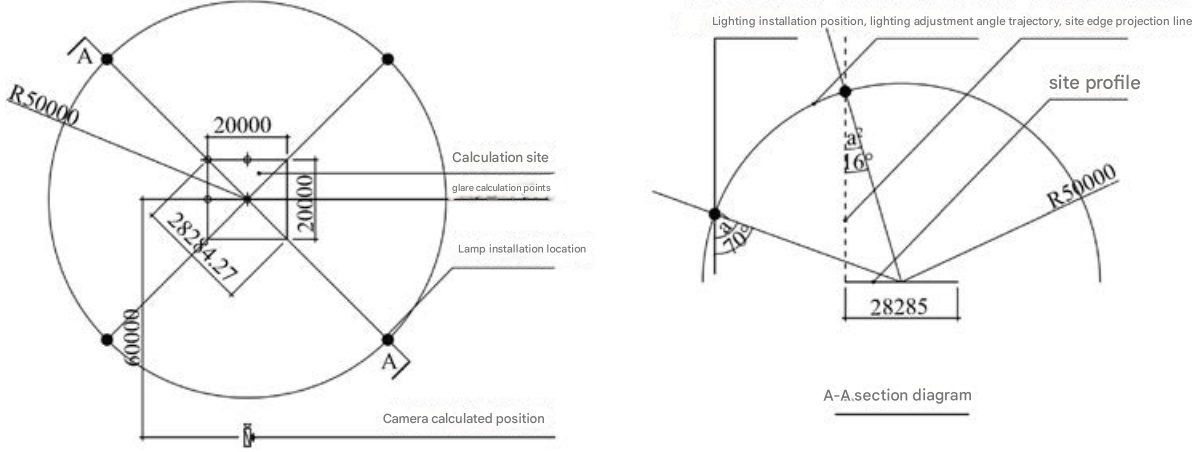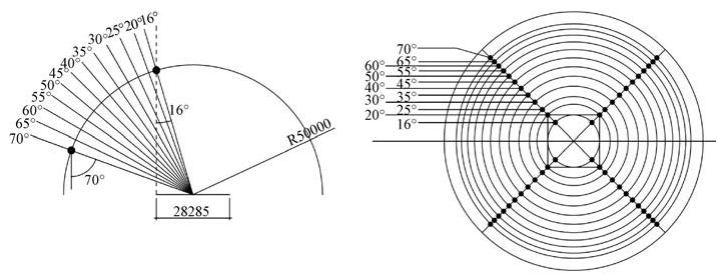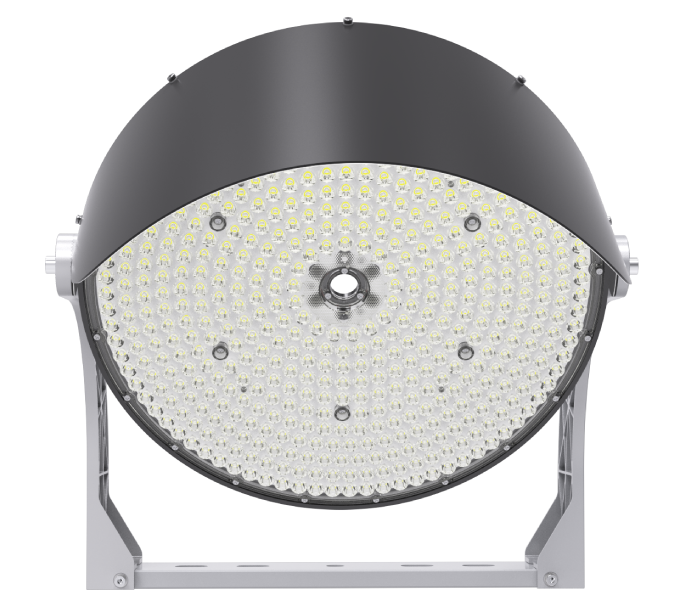Effect of The Sport Field Lights Location On Lighting Indicators
Effect of The Sport Field Lights Location On Lighting Indicators

Directory:
1. Principle of Setup
2. Lamp Positioning Value
3. Quantity of luminaires and the location of the projection target
4. Data and Calculation Results
1. Principle of Setup
In various data groups, the lamp's projection distance is maintained at a constant value, while the projection angle α and the illuminance level of the lamp are treated as two variables. The final data for GR is assessed and tested simultaneously. Other parameters, such as lamp and light source efficiency and the maintenance coefficient (set at 0.8), remain constant.
The area measures 20m × 20m, with the lamp positioned 50 meters from the center of the site, and the camera located 60 meters from the center (at a height of 10 meters), calculated based on a 4-point glare (refer to Figure 1).
2. Lamp Positioning Value
The lamps are installed along the two diagonal extension lines at 45 degrees within the site. Following the principle of equal projection distance, lamp positions are set at angles ranging from 16 to 70 degrees, resulting in a total of 12 groups with an interval of 5 degrees between each.
Fig.1 Schematic diagram for Verification

3. Quantity of luminaires and the location of the projection target
Place one luminaire at each of the four corners, ensuring that the half-intensity beam angle of the luminaire is less than a quarter of the venue's diagonal size. This maximizes light coverage in the venue and minimizes variations in light utilization due to changes in the projection angle. All luminaires should be directed towards the center of the venue, and their height should be determined based on the height shown in Figure 2 to maintain a consistent projection distance.
Fig.2 Schematic diagram of luminaire position

4. Data and Calculation Results
The calculation data encompasses the average horizontal illumination, average vertical illumination from the camera, and the maximum glare value (Grmax). The environmental coefficient is computed twice, using values of 20% and 40%, to represent the calculation outcomes for both the stadium and gymnasium.
The optical specifications of the lamps used in the calculations are as follows:
- Upward light output ratio: 0%
- Downward light output ratio: 81%
- Total light output ratio: 81%
- Luminous flux of the light source: 200,000 lm
- Power of the lamp: 2.133 W
- Half-intensity beam angle of the lamp: 0° to 180° [2 × 7.8°]; 90° to 270° [2 × 8.7°]
- Color temperature of the light source: 5600 K
- Color rendering index: Ra > 90
- Central light intensity: 10.510 cd/1,000 lm
The analysis of the data is as follows:
(1) In Figure 4. the horizontal axis represents the lamp's projection angle (the angle between the lamp's main light axis and the vertical line at the lamp's position), while the vertical axis displays the values for horizontal illuminance, vertical illuminance, and glare calculations.
(2) The numerical results indicate that as the projection angle increases, the horizontal illuminance rises, but this increase is not as significant as that of the vertical illuminance.
(3) When the projection angle shifts from 70 to 40 degrees, the vertical illuminance decreases almost linearly, with the rate of decrease gradually slowing down after reaching 40 degrees.
(4) Once the projection angle hits 25 degrees, the calculated Grmax value is 10.
5. Analysis of Results and Summary
5.1 Connection Between Horizontal and Vertical Illuminance and Projection Angle
(1)As per the guidelines, most broadcast-level sports venues primarily focus on the absolute value of vertical illuminance, while horizontal illuminance is only concerned with its uniformity.
(2)Based on relevant standards and international norms, the ratio of Eh to Ev should be between 0.5 and 2. However, when uniformity is factored in, if the minimum projection angle of the sport field lights is below 25 degrees, this ratio may exceed 2. This results in low vertical illuminance and poor lamp efficiency.
(3)When the projection angle for sport lighting reaches 70 degrees and for gymnasium lighting reaches 65 degrees, the calculated GR value will surpass the established international and domestic standards. Therefore, it is necessary to restrict the maximum projection angle of the lighting (the numerical analysis of GR is provided below).
(4) In determining the installation position of sport lights for sports venues, the focus should be on the projection angle rather than the absolute height of the fixtures. This is because both the Eh/Ev ratio and the calculated GR value depend more on the angle (though the absolute height should still be considered) rather than just the height itself.
(5) The height of sport field lights must be taken into account, as it is primarily influenced by the venue's size and the fixture's projection angle.
(6) Based on the information provided, the projection angle for sport field lights should be limited to a range of 25 to 70 degrees.
(7) The projection angle for stadium lights should fall between 25 and 65 degrees, according to the aforementioned data, which sets the boundaries.
(8) Taking into consideration the building structure and project cost control requirements, a projection angle between 40 and 65 degrees will yield an excellent overall effect.
(9) While a projection angle of around 65 degrees for all lamps would maximize vertical illumination, it is not a practical solution.
(10) A more optimal projection angle for the lamps will result in fewer fixtures needed for sports lighting design, leading to lower investment in the lighting system and reduced energy consumption.
Thus, to minimize both energy use and the number of lamps, it is essential to carefully manage the projection angle of the fixtures, which necessitates collaboration with architectural and structural professionals regarding the installation positions.
5.2 Glare Index GR Concerns
(1) At a lamp projection angle of 70 degrees (though this angle exceeds the limits of the GR calculation formula, it can still serve as a reference), the calculated result using a 20% environmental coefficient already surpasses 50. This exceeds the acceptable range for broadcast-level stadiums. Even with alternative design methods, 70 degrees is the maximum projection angle for sport field lights.
(2) With a lamp projection angle of 65 degrees, the calculation using a 45% environmental coefficient results in a value greater than 30. which also exceeds the permissible range for broadcast-level stadiums. Similar to the previous case, 65 degrees is the maximum projection angle for sport field lights, regardless of other design approaches.
(3) In this analysis, the lamp projection is aimed solely at the center of the venue. However, in practical design, due to the need for uniform illumination (particularly the directional aspect of vertical lighting), the lamp projections in broadcast venues must extend beyond the center line. For HDTV, which demands higher uniformity, lamps may even need to be directed towards the opposite sideline. Therefore, the control of projection angles should be determined based on the farthest projection point.
(4) The environmental coefficient values: 20% is derived from the reflectivity of the stadium grass and surrounding environment, while 45% is based on the reflectivity of the gymnasium floor and the surrounding architectural decor.
6. Related Product

7. Related Blog
